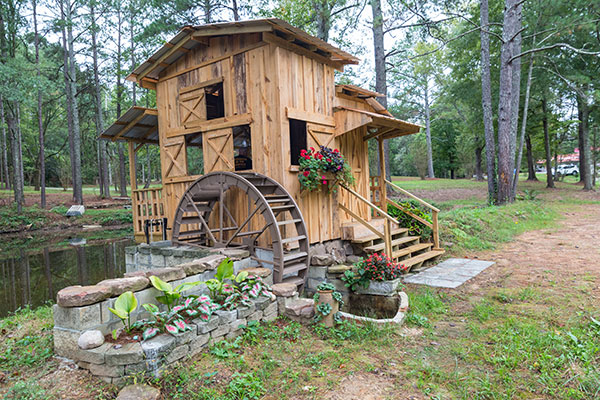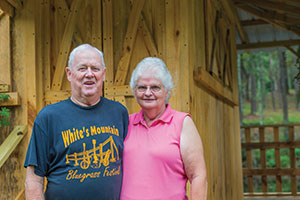

St. Clair Springs couple returns to days gone by
Story by Elaine Hobson Miller
Photos by Michael Callahan
For several of the 40-plus years Tommy and Sibyl White have lived in St. Clair Springs, they have gazed out their living room window at the swampy spring-fed pond across the road and said, “Wouldn’t it be neat to have a water wheel there?”
The pond was on a piece of land that didn’t belong to them, so the couple never dreamed their idea would go anywhere. But the owner decided to sell that four-acre plot, and when Tommy learned about it, he pounced. The deal was sealed early this year, and Tommy set to work clearing the property and building that wheel and a mill to house it.
“Three springs feed the mill pond,” Tommy said. “A stream ran out of it constantly all year round. We thought it would be the perfect place for a water wheel.”
He didn’t have a drawing of what he wanted, but that wasn’t an obstacle. “I had in the back of my head what I wanted it to look like,” he said.
It wasn’t the first time he had plunged feet first into a building project. The host of White’s Mountain Bluegrass Festival for 12 years, he built a wooden train, a general store and an amphitheater and stage at the top of White’s Mountain Lane. Tommy and Sibyl live at the bottom of that lane. When the bluegrass festival got too big for them to handle — they were doing one in the spring and one in the fall — they quit. But the lure of old-time music and old-fashioned folk ways proved too much for them. So about five or six years ago (Tommy isn’t good with dates), he came up with the Chimney Corner Celebration to take its place.
Held the third weekend of October, it is named after the warmest spot in any bygone farm house, the corner between the pot-bellied stove and the fireplace. The Celebration warms up at sundown on a Friday with a jam session of local bluegrass musicians. It continues from 9 a.m. until “whenever” the next day with more bluegrass, bagpipes and other period music and dance. Activities and displays include sorghum syrup and cider making, spinning wheel operations, hominy making, quilting, chair caning and blacksmithing.
 “We just love that kind of stuff,” Tommy said. “The old ways of doing things bring back memories of the old days, when people had to make it, grow it or do without it.”
“We just love that kind of stuff,” Tommy said. “The old ways of doing things bring back memories of the old days, when people had to make it, grow it or do without it.”
The star of the show this year was supposed to be the new mill, but it wasn’t quite finished in time. Tommy had planned to demonstrate grinding corn and wheat, and the water wheel was supposed to produce the electricity to power a generator for the lights of the mill house. The water level was a couple of feet below what the mill wheel needed. So, the demos would have to wait for the rainy season.
He made the eight-foot by two-foot mill wheel in his shop by modifying a metal spool used to roll electrical wire. It’s an undershot mill, meaning water runs under it to turn the wheel. Two grinding stones, one stationary and one moving against the first, form the basic elements for grinding grain. Tommy cut grooves in the mill stones so the grain could pass through them.
“To harness water power, you must have height and volume,” Tommy explained. “To get the volume, you raise the water level and restrict it to a narrow channel that is called the mill race.” The wheel sits at the discharge end of the race, and water pressure will turn the wheel. A control valve will lower and raise the water level. When the wheel runs, water will pass through the mill race and into a stream that continues under Highway 23 and into Little Canoe Creek.
Made of pressure-treated pine lumber and siding, the mill building is 12 feet by 16 feet, including a porch that wraps around two sides. It has traditional mill-style windows, which are openings cut into the siding with wooden covers that slide out of the way. “I remember Mom had windows like these in her kitchen,” Tommy said. “I would go outside and climb up and open them on a hot day.”nnnnnnnnnnnnnnnnnnn
Mosquitoes were a hindrance to the property clearing at first, but Tommy’s son found a $400 fogger machine online, and it cleared out the mosquito population from the quarter-acre pond in a hurry. Once construction started, curious passersby on Highway 23 stopped their cars frequently, asking questions and admiring the project.
Begonias, coleus, geraniums, hasta and caladium add color to the place, along with hanging baskets of ferns and an airplane plant, thanks to Sibyl’s green thumb and eye for landscaping. “I had to contain her, or she would have filled the place with flowers,” Tommy said. “She had some good ideas, though.”
The mill won’t sit dormant between celebrations, either. “I’ll decorate it for the Christmas season and use the electricity the wheel generates to power the lights, provided the rains come and bring up the water level,” he said. “We’ll just grind whatever folks bring us, too.”
Meanwhile, at the top of the lane where the Chimney Corner Celebration is held, Tommy has built a number of buildings that help tell of bygone days. He has a general store and post office combination, something that was quite common in the early history of the U.S. Postal Service.
The back room of the building holds some of the old-fashioned machinery he has collected, including two corn shellers, a grist mill, treadle sewing machines, several ice boxes and a cast-iron cook stove that is vented through a fireplace chimney. An avowed tinkerer, he rebuilt the corn sheller that had belonged to Sibyl’s dad as a boy by using another one as an example.
Shelves in the front room are filled with old glass and pottery, such as the soft-drink bottle embossed with the words, “Ashville Bottling Company,” that he found when he cleaned the sludge out of the mill pond. Post office boxes at the front of the store came from the St. Clair Springs post office that closed around 1949. “St. Clair Springs was a town before Springville was,” he said, a touch of pride in his voice.
He restored a cider mill that he uses at the celebrations. “I found it in northeast Alabama, or rather, I found what was left of it,” Tommy said. “A fellow advertised it on the internet, and I finagled a deal.” Sibyl researched it and had photos and diagrams for him to go by.
Both bluegrass musicians, Tommy plays guitar, and Sibyl keeps the beat on a bass fiddle, while friend David Connor plays banjo in the unnamed trio they form. They play at the Chimney Corner Celebration and area events such as the Looney House Festival, and at the annual Christmas Pickin’ the Whites hold in the back room of the General Store.
In another nod to times gone by, all electricity is turned off at the store that night, and those lucky enough to get an invitation play by the light of the fireplace, oil lamps and lanterns.
Tommy and Sibyl’s granddaughter, six-year-old Caroline, has taken an interest in learning how to play the guitar, and Tommy plans on teaching her what he knows. “We’re calling it Caroline’s Mill in her honor,” Tommy said.















